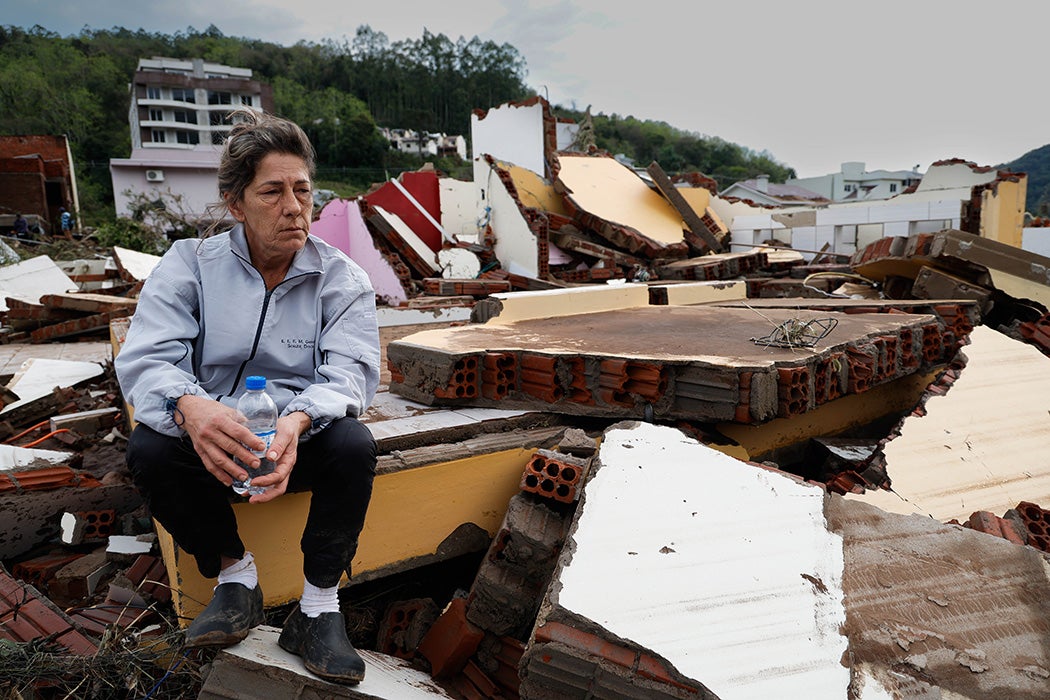In some of my favorite doomsday movies, shows, and literature, such as The Day After Tomorrow, we see a changing climate as the great equalizer—an urgent need for the world to come together to solve the climate crisis, for the sake of the future of humanity. Because this external force has the power to harm us all, the complex social dynamics of justice and equity in these fantasy worlds are often obscured, defaulting to maintaining the status quo. As in superhero movies, no one person is to blame for this external force nor is anyone facing an unequal burden as a result. Oftentimes, a white protagonist unites the world’s most powerful to develop a technology to fight the problem, or escape it all together, engaging in a calculus of living and dying to render who to leave behind.
These narratives are powerful and can sometimes disturbingly reflect real-world climate management and policy, especially in the Global North. Narratives of emergency, even though they’re sometimes ignored by climate denialists all together, have jumpstarted solution-building for the climate crisis: everything from vehicle electrification to replanting trees in degraded ecosystems to developing technology to draw carbon out of the atmosphere.
Thanks to these doomsday stories, and even real-life examples, we’ve seen the danger that weaponizing emergency can have on advocating for the simple trading of fossil fuel conflicts for sustainable conflicts. Reforestation schemes have sometimes resulted in further land-grabbing from Indigenous communities. Carbon accrediting can alter how communities steward their environment—warping nature into a commodity. Discourse on biodiversity offsets has suggested that humans can just move mountains elsewhere, perhaps to less desirable land masses. What such narratives miss is that climate change isn’t purely an ecological issue that can be redressed by simply restoring atmospheric carbon dioxide back to pre-industrial levels. The climate crisis is sociogenic—it’s embedded in the fabric of our social systems and the ways they operate, change, and persist.
“Climate justice or not at all” has been a common call of scholar-activists involved in the sustainability transition. This formulation implies that in the drive for a greener, cleaner world, there hasn’t been an intrinsic reckoning with the systems that jumpstarted the climate crisis. Without embedding a measure for justice into all we do, there’s a risk of repeating and furthering harm to the world’s most vulnerable.
Farhana Sultana, a political geographer, comments on this point, writing that a critical climate justice practice looks like a
praxis of solidarity and collective action…underscores issues of differential exposure, vulnerability and risk. This also involves the re-evaluation of global political economic systems that produce and reinforce socio-spatial injustices.
It’s critical to remember that it’s often human systems that create this power differential—not natural hazards themselves.
Many scholars suggest the beginnings of the climate crisis hark back to the era of imperialism, with the invasion of all livable continents by Western European colonial empires. It was the surplus profit acquired from Indigenous land-grabbing and erasure, the labor from Trans-Atlantic slavery, and the minerals from the African continent that fueled European industrialization, starting the mass release of carbon dioxide through fossil fuel combustion in the 1880s. It’s the accumulation of this carbon dioxide over the course of the following century that has shifted Earth’s system dynamics, warming the world’s land surfaces and carbonizing the oceans. Yet, a significant portion of humanity isn’t playing a role in the emission of greenhouse gasses, or if they are, they’re doing so unwillingly. How can we create solutions that account for the communities that are least active in causing the climate crisis but face its effects first and worst?
Weekly Newsletter
The world’s fight for 1.5°C and net-zero targets by 2050 keeps us in a state of quasi-emergency, not only temporally delaying climate action but also overshadowing the crises of injustice that have been inflicted on communities around the world for centuries. A framework of climate justice has reframed the narrative of the climate crisis, bringing to light the emergencies that are a part of the everyday lived experience and how climate change will exacerbate them. For me, it was difficult to understand the climate crisis as a global crisis when I found the crises of being unable to access healthy, affordable food, living near a landfill, and feeling unsafe in my school more pressing. Without climate justice, there’s no consideration of the holistic issues that envelope how communities experience the climate crisis.
A world with authentic engagement with a praxis of climate justice requires creativity and imagination. As Frederic Jameson once remarked (and Mark Fisher borrowed), “It’s easier to imagine the end of the world than the end of capitalism.” While scholar-activists have differing visions of how a climate justice future could look, without policy and management strategies that address the colonial history of the climate crisis, we risk perpetuating the same systemic injustices that have led us to this point. The urgency of the climate crisis should not blind us to the historical and ongoing forms of injustice that continue to shape our world.







